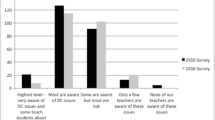Abstract
EduSummIT 2013 featured a working group that examined digital citizenship within a global context. Group members recognized that, given today’s international, regional, political, and social dynamics, the notion of “global” might be more aspirational than practical. The development of informed policies and practices serving and involving as many sectors of society as possible is desirable since a growing world’s population, including students in classrooms, will have continued access to the Internet, mobile devices and social media. Action steps to guide technology integration into educational settings must address the following factors: national and local policies, bandwidth and technology infrastructure, educational contexts, cyber-safety and cyberwellness practices and privacy accountability. Finally, in the process of developing and implementing positive and productive solutions, as many key members and stakeholders as possible who share in—and benefit from—students’ digital lives should be involved, from families and educators to law enforcement authorities, from telecommunication organizations to local, provincial and national leaders.
Similar content being viewed by others
Explore related subjects
Discover the latest articles, news and stories from top researchers in related subjects.References
AboutBeAPro http://www.ikeepsafe.org/be-a-pro/info/.
Bimber, B. (2012). Digital media and citizenship. In H. A. Semetko & M. Scammell (Eds.), The SAGE handbook of political communication (pp. 115–127). London: Sage Publications.
Breslau, J., Aharoni, E., Pedersen, E. R., & Miller, L. L. (2015). A review of research on problematic internet use and well-being. Santa Monica: Rand Corporation.
Brichacek, A. (2014). Infographic: citizenship in the digital age. Retrieved from: http://www.iste.org/explore/articleDetail?articleid=192.
Buckingham, D., & Willett, R. (Eds.). (2013). Digital generations: Children, young people, and the new media. New York: Routledge.
Byers, M. (2005). Are you a global citizen? The Tyee, 5, 1–7.
Chai, C. S., Koh, J. H. L., Ho, H. N. J., & Tsai, C. C. (2012). Examining preservice teachers’ perceived knowledge of TPACK and cyberwellness through structural equation modeling. Australasian Journal of Educational Technology, 28(6), 1000–1019.
Chng, G. S., Li, D., Liau, A. K., & Khoo, A. (2015). Moderating effects of the family environment for parental mediation and pathological internet use in youths. Cyberpsychology, Behavior and Social Networking, 18(1), 30–36.
de Freitas, S., & Ott, M. (Eds.). (2013). New pedagogical approaches in game enhanced learning: curriculum integration. IGI Global.
Erstad, O. (2013). Digital learning lives: Trajectories, literacies, and schooling. New York: Peter Lang.
Green, M. F. (2012). Global citizenship: what are we talking about and why does it matter? Trends and Insights for International Education Leaders, 1–3.
Jiow, H. J. (2015). Singapore’s cybercrime regulation based on Lessig’s modalities of constraint. Asia Research Center. Retrieved from: http://www.murdoch.edu.au/Research-capabilities/Asia-Research-Centre/_document/Working-Paper-Hee-Jhee-JIOW-179WP.pdf.
Koh, J. H. L., & Chai, C. S. (2015). Towards a Web 2.0 TPACK lesson design framework: applications of a Web 2.0 TPACK survey of Singapore preservice teachers. In New media and learning in the 21st Century (pp. 161–180). Singapore: Springer.
Kularski, C. M., & Moller, S. (2012). The digital divide as a continuation of traditional systems of inequality. Sociology, 5151, 14.
Marzano, G., Lubkina, V., & Truskovska, Z. (2013). Cyberspace’s threats: a pedagogical perspective on Internet addiction, violence and abuse. Retrieved from: http://www.researchgate.net/profile/Gilberto_Marzano/publication/259609197_Cyberspaces_threats_a_pedagogical_perspective_on_Internet_addiction_violence_and_abuse/links/0f31752d7b9f9e9c6a000000.pdf.
McQuade, S., & Sampat, N. (2008). Survey of internet and at-risk behaviors. Rochester: Rochester Institute of Technology.
Miller, C., & Doering, A. (Eds.). (2014). The new landscape of mobile learning: Redesigning education in an app-based world. New York: Routledge.
Mossberger, K., Tolbert, C. J., & McNeal, R. S. (2007). Digital citizenship: The internet, society and participation. Cambridge: MIT Press.
Mouza, C., & Lavigne, N. (2012). Emerging technologies for the classroom: A learning sciences perspective. New York: Springer Science & Business Media.
Ohler, J. B. (2010). Digital community, digital citizen. Thousand Oaks, CA: SAGE Publications.
Ong, S. H., & Tan, Y. R. (2014). Internet addiction in young people. Annals of Academy of Medicine, Singapore, 43(7), 378–382.
Parekh, B. (2002). Rethinking multiculturalism: Cultural diversity and political theory. Cambridge: Harvard University Press.
Parekh, B. (2003). Cosmopolitanism and global citizenship. Review of International Studies, 29(1), 3–17.
Parekh, B. (2008). A new politics of identity: Political principles for an interdependent world. New York: Palgrave Macmillan.
Qiu, J. L. (2009). Working-class network society. Communication technology and the information have-less in Urban China. Cambridge: MIT Press.
Resta, P., Searson, M., Patru, M., Knezek, G., & Voogt, J. (2011). Building a global community of policy-makers, researchers and teachers to move education systems into the digital age. Paris: EDUsummIT.
Ribble, M. (2011). Digital citizenship in schools. International Society for Technology in Education. Eugene: ISTE.
Samra, M. (2007). Creating global citizens? The case of ‘Connecting Classrooms’. Diss. Thesis, Retrieved from London School of Economics http://www.lse.ac.uk/collections/media@lse/mediaWorkingPapers/ (Reg. number 70527).
Schattle, H. (2007). The practices of global citizenship. Lanham: Rowman and Littlefield.
Searson, M., Sadeghi, L., Cirasa, R., & Tang, T. (2013). Digital age professional development for college faculty from the ends of the earth! In R. McBride & M. Searson (Eds.), Proceedings of society for information technology & teacher education international conference 2013 (pp. 2646–2648). Chesapeake: AACE. Retrieved December 15, 2013. http://www.editlib.org/p/48510.
Servaes, J. (2013). The many faces of (soft) power, democracy and the internet. Telematics and Informatics, 30(4), 322–330.
Singapore MOE. (2012). 2014 cyber wellness secondary. Singapore Ministry of Education. Student Development Curriculum Division. Retrieved at http://www.ibe.unesco.org/curricula/singapore/si_sc_cplf_2012_eng.pdf.
Van Dijk, J. (2012). The network society. London: Sage Publications.
Wong, P., & Divaharan, S. (2013). ICT for meaningful learning (Singapore). In Case studies on integrating ICT into teacher education curriculum in Asia (pp. 55–70). Bangkok: UNESCO.
Young, D. (2014). A 21st-century model for teaching digital citizenship. Educational Horizons, 92(3), 9–12.
Author information
Authors and Affiliations
Corresponding author
Additional information
Members of the Thematic Working Group 8
Andresen, Bent, Denmark
Edyburn, Dave, USA
Hancock, Marsali USA
Jermol, Mitja, Slovenia
Nusrat, Sohail, Pakistan
Padgett, Helen, USA
Searson, Mike, USA
Sirrine, Ben, USA
Vilela, Adriana, OAS
Rights and permissions
About this article
Cite this article
Searson, M., Hancock, M., Soheil, N. et al. Digital citizenship within global contexts. Educ Inf Technol 20, 729–741 (2015). https://doi.org/10.1007/s10639-015-9426-0
Published:
Issue Date:
DOI: https://doi.org/10.1007/s10639-015-9426-0




